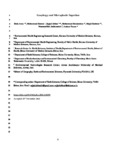Geophagy and microplastic ingestion
Date
2022-03Author
Subject
Metadata
Show full item recordAbstract
Microplastics (MPs) are ubiquitous and pervasive contaminants whose impacts on human health are unclear but are gaining interest in the scientific literature. Human exposure to MPs may arise through inhalation and ingestion, with research into the latter route focusing on foodstuffs and beverages contaminated from the environment or during processing and preparation. What has not been considered thus far, however, is MP exposure through geophagy, or the cultural, culinary or compulsive ingestion of contaminated soil and dirt. In this study, soils from the island of Hormoz, Iran, and spices prepared from these soils were analysed for MP contamination. Fibres of polyethylene terephthalate, nylon, polystyrene or polypropylene were detected in the soils and a composite spice derived from packaged products, with the MP concentration greatest in the latter sample (0.1 MP g−1). Although typical consumption of this material results in MP exposure that is lower than that arising from the dietary consumption of fish and bottled water, for example, geophagy more generally may represent a significant means of exposure for humans and animals that deliberately ingest geosolids.
Publisher
Journal
Volume
Pagination
Number
Recommended, similar items
The following license files are associated with this item:


